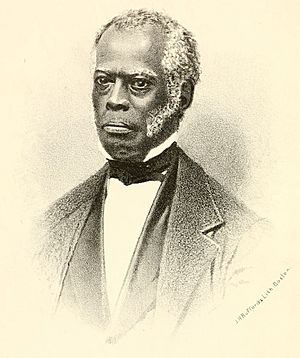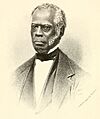Lunsford Lane facts for kids
Lunsford Lane (born May 30, 1803 – died June 27, 1879) was a very smart and brave businessman from North Carolina. He was born into slavery but managed to buy his own freedom and later the freedom of his entire family. He became a strong voice against slavery and even wrote a book about his life. His story shows how hard life was for enslaved people, even for those who had more opportunities.
Contents
Lunsford Lane's Early Life
Lane was born near Raleigh, North Carolina. His parents, Edward and Clarissa Lane, were enslaved house servants. This meant they worked inside the home of their owner, Sherwood Haywood. Lunsford also became a servant in the Haywood family. This gave him more chances than enslaved people who worked in the fields. But he still dreamed of being free.
How Lane Earned Money
Lunsford started earning money by selling a basket of peaches his father gave him. This was the beginning of his many business ideas. He sold marbles and saved money given to him by visitors. His father taught him how to prepare smoking tobacco. Lunsford made his own special tobacco that tasted sweet. He made it at night after his house duties were done.
He also made pipes from reeds, hot wire, and clay. He sold these pipes early in the night. Many local lawmakers bought his products. This helped him grow his business and hire others to sell for him. He became known as a tobacconist, even while working as a house servant during the day. He also sold firewood, worked as a handyman, and was a messenger in Governor Edward B. Dudley's office.
Gaining Freedom
When Sherwood Haywood died, his wife had to rent out Lunsford. This was good for him because he could rent himself out for about $100 to $120 each year. Eventually, he saved enough money to buy his own freedom for $1000.
In May 1828, he married Martha Curtis, and they had seven children. It would take him another 18 years to buy his family's freedom. North Carolina law made it hard for enslaved people to become free unless they had done "meritorious service." So, in 1835, Lane traveled with a friend to New York, where he was officially granted his freedom.
Challenges and Activism
Five years later, in 1840, Lunsford learned that because he became free in New York, he was breaking a North Carolina law. This law said that free Black people from other states could not stay in North Carolina for more than 20 days. He asked for an exception but was forced to leave the next year.
Since he couldn't live in his hometown, he moved north to New York and Boston. There, he earned money to free his family by speaking at meetings against slavery.
In Baltimore, Lane and a friend were arrested. A slave trader claimed they were runaways. Even though they had papers proving they were free, they had to go to trial. They were set free after the trader couldn't show proof, and a young lawyer gave a strong speech defending Lane. At that time, it was common for free Black people to be kidnapped or falsely accused of being runaway slaves.
A Dangerous Return Home
In 1842, Lunsford returned to Raleigh to buy the rest of his family. Even though he had been promised safety, he was arrested for giving speeches against slavery in the North. He was released, but then a mob took him to the woods. They attacked him by tarring and feathering him. His white friends in Raleigh saved him and helped him escape on a train with his family. Mrs. Haywood also gave him his mother. They settled in Philadelphia, and later his father joined them.
Life in the North
Soon after arriving in Philadelphia, the Lanes moved to Massachusetts. They lived first in Boston and then in 1845, moved to Cambridge, where his youngest daughter was born. Records show that Lane worked as a book agent, a doctor, and a maker of patent medicines. In 1863, he was working as a steward at Wellington's Hospital in Worcester, Massachusetts.
After his youngest daughter died in April 1872, Lunsford Lane moved to Greenwich Village in New York City. He passed away in June 1879 from an illness related to old age. Before he died, he helped start a school in New Bern, North Carolina.
In 2019, a historical marker honoring him was placed on Edenton Street in Raleigh.
The Narrative of Lunsford Lane
In 1842, Lunsford Lane published his autobiography. It was called The Narrative of Lunsford Lane, Formerly of Raleigh, N.C. Embracing an Account of His Early Life, the Redemption by Purchase of Himself and Family from Slavery, and His Banishment from the Place of His Birth for the Crime of Wearing a Colored Skin.
His book was very popular and was printed three more times in six years.
About Lunsford Lane
Most of what we know about Lunsford Lane comes from his own book and a biography written by William George Hawkins called Lunsford Lane; or, Another Helper from North Carolina. He also has a chapter in John Spencer Bassett's book Anti-Slavery Leaders of North Carolina from 1898.
Images for kids
See also
- Moses Grandy
- List of slaves



